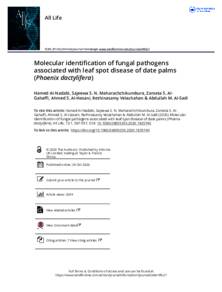Document
AFLP fingerprinting analysis of citrus cultivars and wild accessions from Oman suggests the presence of six distinct cultivars.
Identifier
DOI: 10.2478/agri-2018-0018
Source
Agriculture (Pol'nohospodarstvo). v. 64, 4, p. 173-182
Contributors
Country
Germany.
Publisher
De Gruyter Open Ltd.
Gregorian
2018-01-01
Language
English
Subject
English abstract
A study was conducted to evaluate genetic relatedness of 27 citrus cultivars and 6 wild citrus accessions using AFLP fingerprinting. The 27 citrus cultivars belonged to Citrus sinensis, C. aurantifolia, C. aurantium, C. paradise, C. reticulata, C. limon, C. latifolia, C. maxima, C. limettoides, C. limetta, C. medica and C. Jambhiri. The wild cultivars were obtained from Oman while the other cultivars originated from Oman and other countries. AFLP analysis using 4 primer pair combinations resolved 910 polymorphic alleles. All citrus cultivars and accessions had low genetic diversity (H = 0.0281 to 0.1300), with the percent polymorphic loci ranging from 8 to 35%. Populations of the six wild citrus accessions showed a very low level of genetic diversity ( 0.0700). Cluster analysis of the 33 cultivars and accessions showed that they share a high level of genetic similarity (81‒99%; mean = 92%). The six wild accessions clustered into two main clusters, with the analysis indicating that the six wild accessions may make up six distinct cultivars. The study provides information on the phylogeny of citrus cultivars and citrus diversity in Oman, a country through which citrus moved in the past from Asia to different African and European countries. In addition, it shows that some distinct citrus cultivars are present in this part of the world.
ISSN
0551-3677
Category
Journal articles


